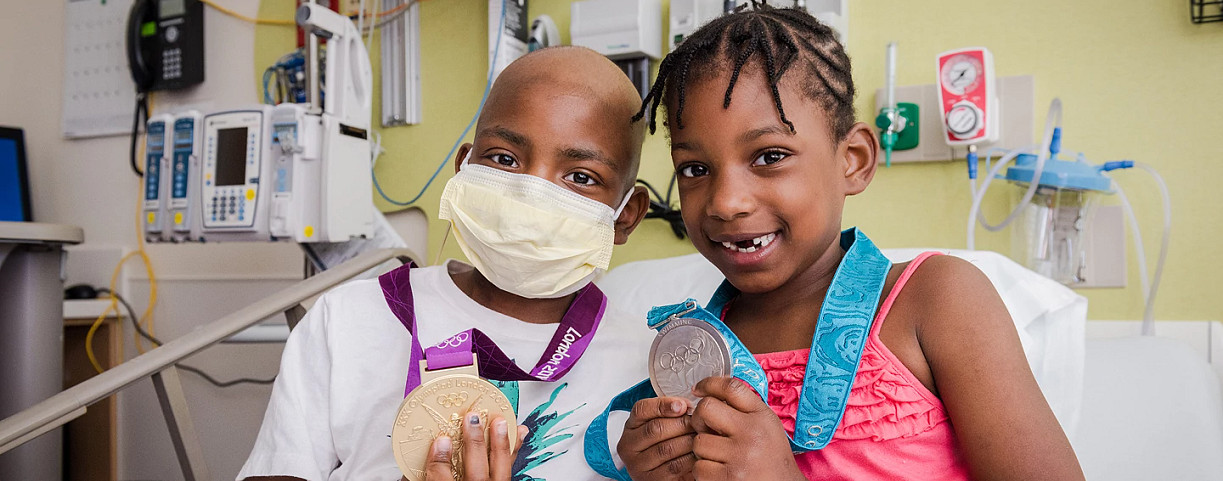On any given day, thousands of men, women, and children who have been diagnosed with life-threatening blood diseases such as leukemia and lymphoma search for a life-saving bone marrow donor to provide healthy stem cells through a process known as allogeneic transplant.
Approximately 30 percent of patients in need of a stem cell donor find a match within their families. The remaining 70 percent search a worldwide database of unrelated volunteer donors, who may be their match and are willing to donate life-saving cells.
If you are interested in becoming a potential stem cell donor, you can join the Be The Match Registry® of the National Marrow Donor Program (NMDP). Being part of this registry means you are ready to donate your stem cells and are ready to save the life of any patient in need of a transplant. YOU could be someone's cure. YOU could save a life.
To join the registry, you must be:
- 18 to 40 years old
- Willing to donate to any patient in need
- Able to meet certain health guidelines
To learn more or to join the registry, visit the Be The Match website.
Dana-Farber's Donor Services Program
Our Donor Services program supports the Dana-Farber Brigham Cancer Center Stem Cell Transplantation Program, one of the largest and most experienced transplant services in the world. Our program manages donations from patients' related family members and acts as a collection center for both related and volunteer unrelated donors.
Our program:
- Conducts searches of the global registries to identify optimal donor matches for patients
- Educates related donors about the donation process
- Acts as a donor's advocate throughout the donation process
- Has a dedicated Donor Services clinical team who cares for the donor throughout the donation process, and ensures donation is safe for the donor
- Is an accredited bone marrow and peripheral blood stem cell collection center
- Includes the Cord Blood Donation Program at Brigham and Women's Hospital
- Connects patients and families interested in supporting volunteer unrelated donor recruitment with the NMDP Be The Match Registry
Donate for a Family Member
When a patient undergoes an allogeneic transplant, the healthy stem cells used in transplantation are donated from another person.
This donor is selected on the basis of how well his or her Human Leukocyte Antigen (HLA) matches that of the patient. The first step in searching for a donor for a patient is for family members of the patient to get HLA-typed. The patient's doctor will let the patient know which family members should be HLA-typed and when this should happen.
Your HLA type is inherited from your parents: one half from your mother and one half from your father. Just as you and your siblings may have inherited similar features, such as hair or eye color, you may also have inherited the same HLA type. The likelihood of finding an HLA match with a family member is approximately 25 to 30 percent.
HLA typing begins with a cheek swab to collect a tissue sample to analyze. It may also be done by taking a sample of blood. Typing includes:
- Serological typing, which is a broad definition of your bone marrow type
- Then, more specific typing is done using a DNA method
Your bone marrow "type" is designated by a series of 10 alpha-numeric combinations. There are millions of possible combinations.
If you are found to be an HLA match for your family member, you will begin the process to become a donor. A donor coordinator from our team will work with you throughout the process, which includes:
- Medical testing to ensure it is safe for you to donate
- Consent
- Donation
- Follow-up
Our donor coordinators will also work with you to ensure that you understand the commitment you are making as a donor, helping you to locate resources including access to a pharmacy, psychosocial services, and other important programs.
If a family member is not a match for the patient, then a search will be performed to find an unrelated, volunteer donor.
If you were tested for a family member and not found to be a match, you may wish to join NMDP Be The Match Registry, which is the largest, most diverse volunteer donor registry in the world. Learn more about joining the Be The Match Registry.
Our donor coordinators will also work with you to ensure that you understand the commitment you are making as a donor, helping you to locate resources including access to a pharmacy, psychosocial services, and other important programs.
If a family member is not a match for the patient, then a search will be performed to find an unrelated, volunteer donor.
If you were tested for a family member and not found to be a match, you may wish to join NMDP Be The Match Registry, which is the largest, most diverse volunteer donor registry in the world. Learn more about joining the Be The Match Registry.
